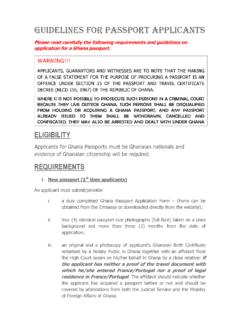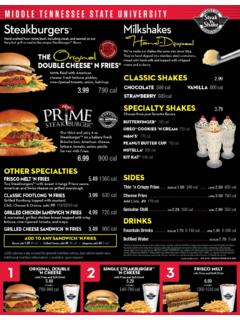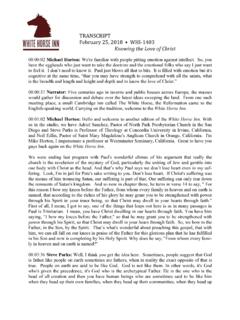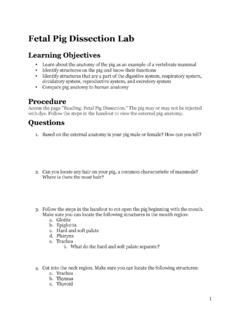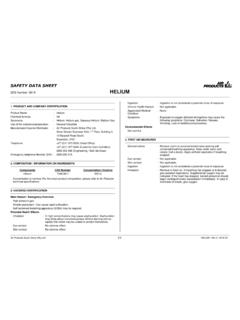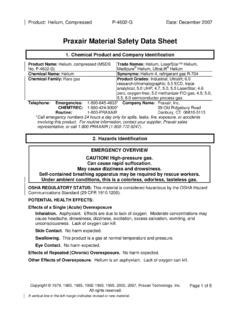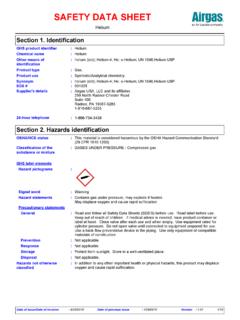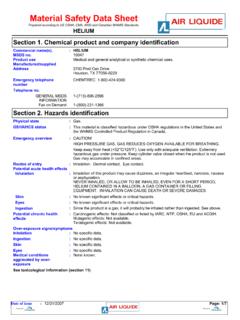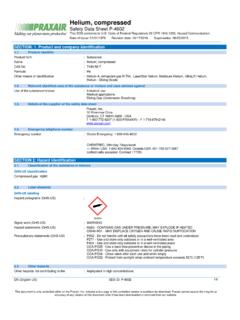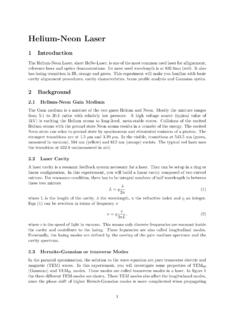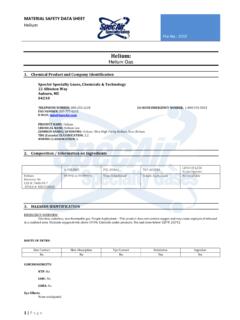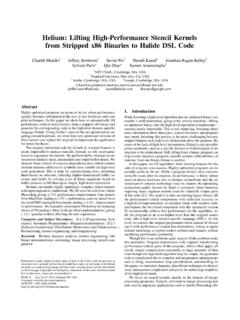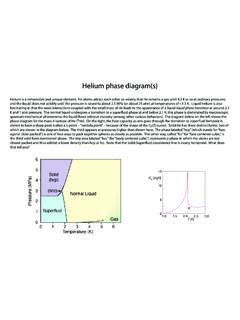Transcription of Helium
1 HeliumA Decentralized Machine NetworkAmir HaleemAndrew AllenAndrew ThompsonMarc NijdamRahul GargHelium Systems, (2018-05-09)AbstractThe Internet of Things is an $800 billion industry, with billion connected devices online, and spending predictedto reach nearly $ trillion by 2021 [1]. Most of thesedevices need to connect to the Internet to function. However,current solutions such as cellular, WiFi, and Bluetooth aresuboptimal: they are too expensive, too power hungry, or toolimited in is adecentralized machine networkthat enables ma-chines anywhere in the world to wirelessly connect to theInternet and geolocate themselves without the need for power-hungry satellite location hardware or expensive cellular the network is a blockchain with a native protocoltoken incentivizing a two-sided marketplace between cover-age providers and coverage consumers.
2 With the introductionof a blockchain, Helium injects decentralization into an in-dustry currently controlled by monopolies. The result is thatwireless network coverage becomes a commodity, fueled bycompetition, available anywhere in the world, at a fraction ofcurrent s secure and open-source primitives enable develop-ers to build low-power, Internet-connected machines quicklyand cost-effectively. Helium has a wide variety of applica-tions across industries and is the first decentralized machinenetwork of its IntroductionThe world is becoming decentralized. A multitude of plat-forms, technologies, and services are moving from cen-tralized proprietary systems to decentralized, open networks such as Napster (created by Heliumfounder Shawn Fanning) [2] and BitTorrent paved the wayfor blockchain networks and crypto-currencies to be Bitcoin, Ethereum, and other blockchain networks haveshown the value of decentralized transaction ledgers.
3 Exist-ing Internet services such as file storage, identity verification,and the domain name system are being replaced by modernblockchain-based versions. While software-level decentraliza-tion has moved quickly, physical networks are taking longerto affect. These networks are more complicated to decentral-ize as they often require specialized hardware to is a wide-area wireless networking system, a block-chain, and a protocol token. The blockchain runs on a newconsensus protocol and a new kind of proof, calledProof-of-Coverage. Miners who are providing wireless networkcoverage in a cryptographically verified physical location andtime submit proofs to the network, and the miners submittingthe best proofs are elected to an asynchronous byzantine faulttolerant consensus group at a fixed epoch.
4 The members of theconsensus group receive encrypted transactions submitted byother miners and forms them into blocks at an extremely hightransaction rate. In addition to the blockchain protocol, theHelium Wireless protocol,WHIP, provides a bi-directionaldata transfer system between wireless machines and theInternet via a network of independent providers that doesnot rely on a single coordinator, where: (1) machines pay tosend & receive data to the Internet and geolocate themselves,(2) miners earn tokens for providing network coverage, and(3) miners earn fees from transactions, and for validating theintegrity of the :This whitepaper represents a continuous work inprogress.
5 We will endeavor to keep this document currentwith the latest development progress. As a result of the on-going and iterative nature of our development process, theresulting code and implementation is likely to differ fromwhat is represented in this invite the interested reader to peruse the Helium GitHubrepo we continue toopen-source various components of the system over Key ComponentsHelium is built around the following key components:Proof-of-CoverageWe present a computationally inexpen-siveProof-of-Coveragethat allows miners to prove theyare providing wireless network coverage.
6 We anchor theseproofs using aProof-of-Serializationthat allows minersto prove they are accurately representing time relative toothers on the network in a cryptographically secure NetworkWe demonstrate an entirely new purpose-built blockchain network built to service theWirelessProtocoland provide a system for authenticating andidentifying machines, providing cryptographic guaranteesof data transmission and authenticity, offer transactionprimitives designed around the wireless protocol, Consensus ProtocolWe present a novel consensusprotocol construction that creates a permissionless, highthroughput, censor-resistant system by combining anasynchronous Byzantine Fault Tolerant protocol withidentities presented ProtocolWe introduce a new open-source andstandards-compliant wireless network protocol, calledWHIP.
7 Designed for low power machines over vast protocol is designed to run on existing commodity ra-dio chips available from dozens of manufacturers with noproprietary technologies or modulation schemes outline a system for interpreting thephysicalgeolocationof a machine using WHIP withoutthe need for expensive and power-hungry satellite locationhardware. Machines can make immutable, secure, andverifiable claims about their location at a given momentin time which is recorded in the System Overview Helium is aDecentralized Machine Networkbuilt arounda new wireless protocol (WHIP) on a purpose-builtblockchain with a native token.
8 Machines take the form of hardware containing a radiochip and firmware compatible with WHIP, and spendtokens by paying Miners to send data to and from theInternet. Miners earn tokens by providing wireless network cover-age via purpose-built hardware which provides a bridgebetween WHIP and Routers, which are Internet applica-tions. Machines store their private keys in commodity key-storage hardware and their public keys in the blockchain. Miners join the network by asserting their satellite-derivedlocation, a special type of transaction in the blockchain,and staking a token deposit.
9 Miners specify the price they are willing to accept fordata transport andProof-of-Locationservices, and Routersspecify the price they are willing to pay for their Ma-chine s data. Miners are paid once they prove they havedelivered data to the Machines specified Router. Miners participate in the creation of new blocks in theblockchain by being elected to an asynchronous ByzantineFault Tolerant consensus group. Miners are rewarded with newly minted Helium for blocksthat are created while they are part of the consensus group. A Miner s probability of being elected to the consensusgroup at a given epoch is based on the quality of thewireless network coverage they provide.
10 The blockchain employsProof-of-Coverageto guaranteethat miners are honestly representing the wireless networkcoverage they are creating.[Figure 1] shows a visual representation of the The Helium DMNWe introduce the Helium Decentralized Machine Network(DMN). TheDMNprovides wireless access to the Internetfor machines by way of multiple independent miners, andoutlines a network and wireless protocol specification bywhich participants in the network should conform. Routerspay this network of miners for sending data to and from theInternet, and miners are rewarded with newly minted tokensfor providing network coverage and delivering machine datato the ParticipantsThere are three types of participants in the network: Machine,Miner, or a and receive encrypted data from the Internetusing hardware compatible with the Helium wirelessprotocol, calledWHIP[Section ].

